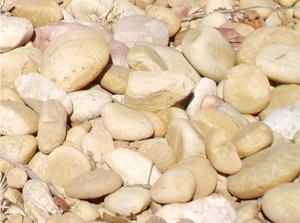Les
Cailloux
de
Châteauneuf-du-Pape

English:
During the miocene period (7.246–5.332 million years ago), the oceans withdrew
and the continents started to become visible. In the eroded Alp
Mountains, rocky boulders broke off valley walls, creating a layer
of stones that were brought from the Alps by the waters of melting
glaciers and finally found their way down to the south, producing
the Rhône’s ancient river bed. In the Venaissin County, where
Châteauneuf-du-Pape is located, the sea waters were shallow and the
heaviest rocks (today known as the “Cailloux” or
“Galets Roulées” of alpine quartzite) resisted the
currents pulling them out to sea. Rolled about by the river, they
were spread out over the highest plains and this created this
unique site. In places, like the one we are standing here, they
created a layer that can be up to two meters deep. Underneath these
“cailloux” a strip of red clay regulates the amount of
water reaching the vineyards. In this “terroir” the
local grapes Grenache, Syrah and Mourvèdre produce the famous
Châteauneuf-du-Pape wines that are generous, powerful, tannic and
concentrated.

The assignment:
1) What is the colour of the “Cailloux” you can find
here?
2) Take two “Cailloux” and smash them a couple of
times. What is the typical smell you can observe from these
quartzite stones?
3) Take a huge “Caillou” (one of the many you can find
here). What is the size (estimated outline) of such a
“Caillou”?
4) Optionally, take a picture of yourself with this
“Caillou” in your hand and add this picture to your
log.
5) Send your answer (for 1 to 3) in an e-mail to the creator of
this cache.
Français:
A
l’époque miocène, les mers se retirent et les continents se
dessinent. Dans les Alpes érodées, des blocs rocheux se détachent
des flancs des vallées en une nappe de Cailloux qui se déverse vers
le Sud, pour former l’ancien lit du Rhône. Dans le Comtat
Venaissin, berceau de Châteauneuf-du-Pape, les eaux de la mer
Astienne sont peu profondes et les Cailloux les plus lourds
(quartzites alpins) échappent à l’entraînement au large.
Roulés par le fleuve, ils recouvrent les hautes terrasses. A
certains endroits, comme ici, ils constituent une couche pouvant
atteindre deux mètres, sous laquelle on trouve un banc
d’argiles rouges. Sur ces sols, les cépages locaux, le
Grenache, la Syrah et le Mourvèdre produisent des vins généreux,
puissants, tanniques et concentrés.
La mission:
1) Quelle est le couleur des "Cailloux" qu’on trouve
ici?
2) Prenez deux "Cailloux" et cassez les pierres quelque fois.
Quelle est l’odeur typique des pierres quartzites qu’on
peut observer?
3) Prenez un "Caillou" grand. Combien est la circonférence
(estimation) de cette pierre?
4) Envoie dans un e-mail les répons (1 à 3) au créateur de la
cache.
5) Optionnel, prenez une photo de vous même avec le
“Caillou”, tu as mesuré, dans ta main et augmente la
photo avec le log.